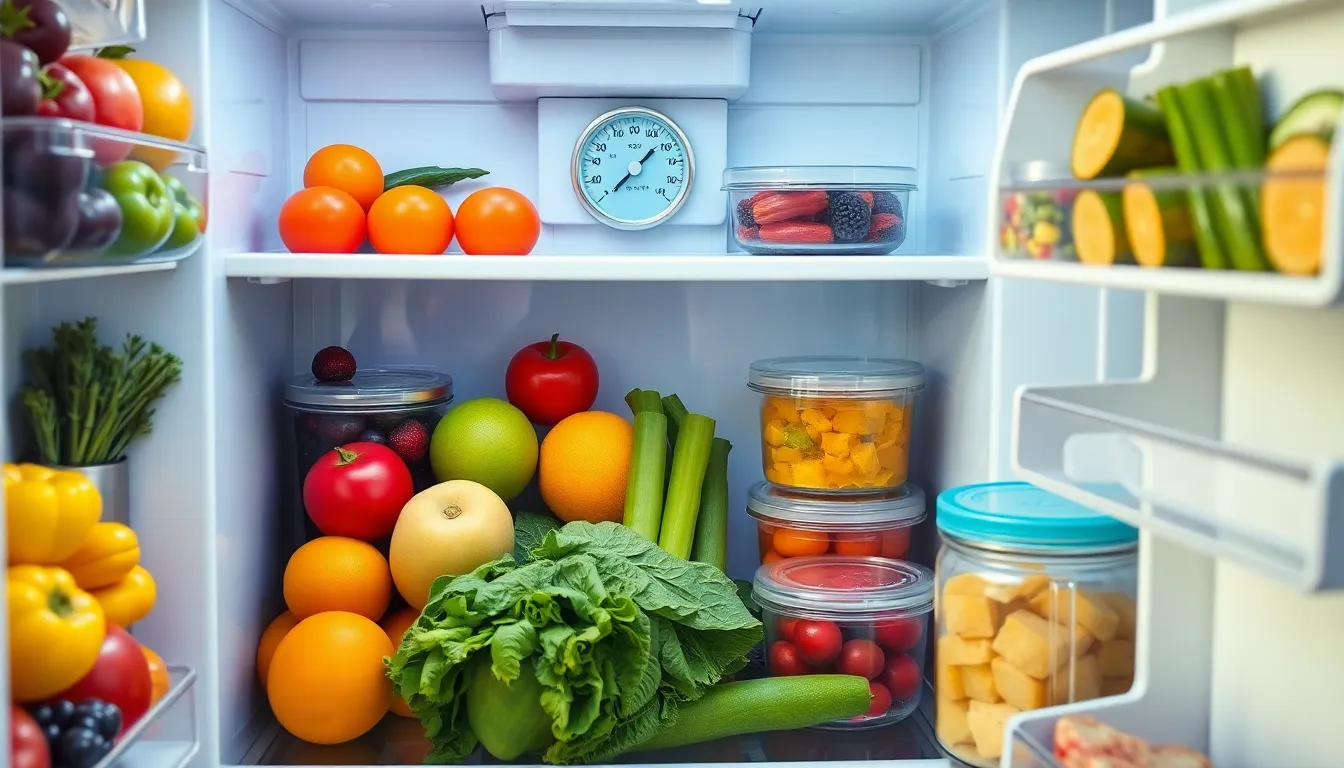Ever opened your fridge only to find a science experiment lurking in the back? Spoiled food isn’t just a waste of money; it’s a culinary tragedy. With the right food storage tips, you can keep your groceries fresher than a morning dew and your wallet happy.
Table of Contents
ToggleEssential Food Storage Tips
Understanding food storage techniques enhances freshness and minimizes waste. First, keep your refrigerator at 32°F to 40°F (0°C to 4°C). This temperature range slows bacterial growth, preserving the quality of perishables.
Next, utilize airtight containers for dry goods. These containers reduce air exposure, preventing spoilage and extending shelf life. Label and date each container to track freshness, ensuring you consume items in a timely manner.
Additionally, wrap fruits and vegetables separately. Certain fruits emit ethylene gas, which can accelerate spoilage in vegetables. Proper separation keeps produce fresh longer.
Use your freezer strategically for meal prep. Cooked meals or unpeeled vegetables can maintain their quality for up to three months when frozen correctly. Portioning meals into smaller containers facilitates quicker thawing.
Monitor expiration dates regularly. This action encourages using older items first and prevents unnecessary waste. Organizing your pantry or fridge with a “first in, first out” method promotes better inventory management.
Consider vacuum sealing for longer storage. This method removes air from packages, extending the shelf life of items significantly. For example, vacuum-sealed meats can last up to two years without losing quality.
Lastly, ensure dry goods remain in a cool, dark place. Exposure to moisture and light can diminish quality. A consistent storage environment helps maintain the integrity of products.
Adopting these food storage tips leads to fresher groceries and less wasted food. Following these methods contributes to both financial savings and better culinary experiences.
Proper Storage Techniques

Proper storage techniques significantly extend the shelf life of food items. Implementing these methods guarantees fresher groceries and reduces waste.
Refrigeration Guidelines
Refrigerators maintain optimal freshness when temperatures range from 32°F to 40°F. Ensure that items are organized to allow air circulation, promoting even cooling. Storing raw meats on the bottom shelf prevents juices from contaminating other foods. Separate fruits and vegetables; this stops ethylene gas from triggering early spoilage. Sealed containers for leftovers keep flavors intact and minimize odors, enhancing overall freshness. Check temperatures regularly; an accurate thermometer ensures safe storage conditions.
Freezing Methods
Freezing food preserves its quality and extends its usability. Use airtight bags or containers to prevent freezer burn and enhance texture. Divide large quantities into smaller portions; this makes defrosting easier. Label items with dates to track freshness. Blanch vegetables before freezing; this method maintains color and nutrients. Thaw food safely in the refrigerator, not on the counter; this prevents bacterial growth. Regularly check the freezer for frost buildup; maintaining cleanliness improves efficiency.
Food Storage Containers
Food storage containers play a crucial role in maintaining food freshness and reducing waste. Selecting the right type enhances food preservation.
Material Types
Plastic containers are lightweight and often stackable. Glass options provide visibility and are non-reactive with food, making them ideal for sauces and marinades. Silicone containers offer flexibility and resistance to temperature changes. Stainless steel containers ensure durability and prevent odors, suitable for storing leftovers. Each material has advantages depending on the food type and intended storage duration.
Choosing the Right Size
Choosing the right size of container optimizes storage efficiency. Smaller containers work well for leftovers, while larger ones suit bulk items such as grains or cereals. Finding a balance in sizes promotes space-saving in refrigerators and cabinets. Selecting containers with tight-fitting lids prevents moisture loss and contamination. When storing items, grouping similar sizes together enhances organization and accessibility.
Common Food Storage Mistakes
Many people unknowingly make mistakes that can lead to spoiled food and wasted money. Storing food improperly can accelerate spoilage, so understanding these common pitfalls is essential.
One common error involves neglecting to check refrigerator temperatures. Keeping the temperature above 40°F prevents the ideal environment for bacterial growth.
Another mistake is overcrowding shelves. Proper air circulation is crucial for maintaining consistent temperatures throughout the refrigerator. Overloaded spaces create warm spots that can spoil items.
Using mismatched containers often complicates food storage. Airtight containers should be reserved for dry goods to keep them fresh longer. Not selecting the right container can lead to moisture loss, making food go stale.
Failing to wrap fruits and vegetables separately ranks high among mistakes. Ethylene gas emitted by certain fruits can spoil nearby vegetables. Keeping them apart significantly extends their shelf life.
Many individuals overlook expiration dates, leading to the consumption of outdated products. Monitoring these dates encourages timely use and reduces food waste.
Not labeling food items similarly contributes to confusion. Clear labeling with dates not only assists in meal planning but also helps in managing what needs to be consumed first.
Lastly, storing raw meats incorrectly leads to contamination risks. It’s essential to place raw meats on the bottom shelf to prevent juices from dripping onto other foods. Taking this step ensures safer food storage practices.
Implementing effective food storage techniques can transform the way groceries are managed. By maintaining the right temperatures and using appropriate containers, individuals can significantly extend the shelf life of their food. Simple practices like organizing items for air circulation and monitoring expiration dates can lead to fresher produce and reduced waste.
Adopting these strategies not only saves money but also enhances meal planning and preparation. With a focus on proper storage methods and awareness of common mistakes, anyone can enjoy the benefits of fresher food and a more efficient kitchen. Embracing these tips will create a positive impact on both culinary experiences and household budgets.



